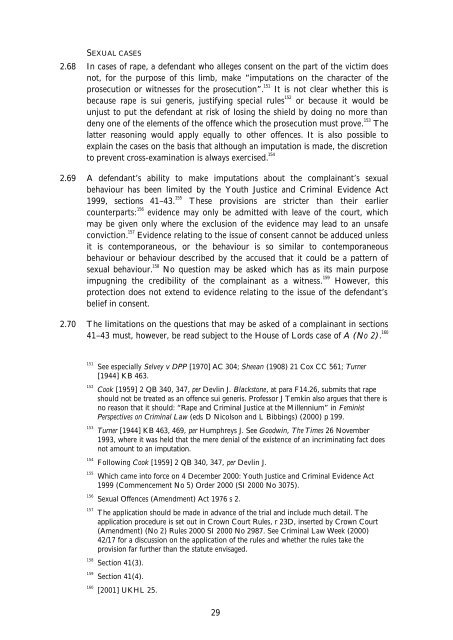Evidence of Bad Character in Criminal ... - Law Commission
Evidence of Bad Character in Criminal ... - Law Commission
Evidence of Bad Character in Criminal ... - Law Commission
Create successful ePaper yourself
Turn your PDF publications into a flip-book with our unique Google optimized e-Paper software.
SEXUAL CASES<br />
2.68 In cases <strong>of</strong> rape, a defendant who alleges consent on the part <strong>of</strong> the victim does<br />
not, for the purpose <strong>of</strong> this limb, make “imputations on the character <strong>of</strong> the<br />
prosecution or witnesses for the prosecution”. 151 It is not clear whether this is<br />
because rape is sui generis, justify<strong>in</strong>g special rules 152 or because it would be<br />
unjust to put the defendant at risk <strong>of</strong> los<strong>in</strong>g the shield by do<strong>in</strong>g no more than<br />
deny one <strong>of</strong> the elements <strong>of</strong> the <strong>of</strong>fence which the prosecution must prove. 153 The<br />
latter reason<strong>in</strong>g would apply equally to other <strong>of</strong>fences. It is also possible to<br />
expla<strong>in</strong> the cases on the basis that although an imputation is made, the discretion<br />
to prevent cross-exam<strong>in</strong>ation is always exercised. 154<br />
2.69 A defendant’s ability to make imputations about the compla<strong>in</strong>ant’s sexual<br />
behaviour has been limited by the Youth Justice and Crim<strong>in</strong>al <strong>Evidence</strong> Act<br />
1999, sections 41–43. 155 These provisions are stricter than their earlier<br />
counterparts: 156 evidence may only be admitted with leave <strong>of</strong> the court, which<br />
may be given only where the exclusion <strong>of</strong> the evidence may lead to an unsafe<br />
conviction. 157 <strong>Evidence</strong> relat<strong>in</strong>g to the issue <strong>of</strong> consent cannot be adduced unless<br />
it is contemporaneous, or the behaviour is so similar to contemporaneous<br />
behaviour or behaviour described by the accused that it could be a pattern <strong>of</strong><br />
sexual behaviour. 158 No question may be asked which has as its ma<strong>in</strong> purpose<br />
impugn<strong>in</strong>g the credibility <strong>of</strong> the compla<strong>in</strong>ant as a witness. 159 However, this<br />
protection does not extend to evidence relat<strong>in</strong>g to the issue <strong>of</strong> the defendant’s<br />
belief <strong>in</strong> consent.<br />
2.70 The limitations on the questions that may be asked <strong>of</strong> a compla<strong>in</strong>ant <strong>in</strong> sections<br />
41–43 must, however, be read subject to the House <strong>of</strong> Lords case <strong>of</strong> A (No 2). 160<br />
151 See especially Selvey v DPP [1970] AC 304; Sheean (1908) 21 Cox CC 561; Turner<br />
[1944] KB 463.<br />
152 Cook [1959] 2 QB 340, 347, per Devl<strong>in</strong> J. Blackstone, at para F14.26, submits that rape<br />
should not be treated as an <strong>of</strong>fence sui generis. Pr<strong>of</strong>essor J Temk<strong>in</strong> also argues that there is<br />
no reason that it should: “Rape and Crim<strong>in</strong>al Justice at the Millennium” <strong>in</strong> Fem<strong>in</strong>ist<br />
Perspectives on Crim<strong>in</strong>al <strong>Law</strong> (eds D Nicolson and L Bibb<strong>in</strong>gs) (2000) p 199.<br />
153 Turner [1944] KB 463, 469, per Humphreys J. See Goodw<strong>in</strong>, The Times 26 November<br />
1993, where it was held that the mere denial <strong>of</strong> the existence <strong>of</strong> an <strong>in</strong>crim<strong>in</strong>at<strong>in</strong>g fact does<br />
not amount to an imputation.<br />
154 Follow<strong>in</strong>g Cook [1959] 2 QB 340, 347, per Devl<strong>in</strong> J.<br />
155 Which came <strong>in</strong>to force on 4 December 2000: Youth Justice and Crim<strong>in</strong>al <strong>Evidence</strong> Act<br />
1999 (Commencement No 5) Order 2000 (SI 2000 No 3075).<br />
156 Sexual Offences (Amendment) Act 1976 s 2.<br />
157 The application should be made <strong>in</strong> advance <strong>of</strong> the trial and <strong>in</strong>clude much detail. The<br />
application procedure is set out <strong>in</strong> Crown Court Rules, r 23D, <strong>in</strong>serted by Crown Court<br />
(Amendment) (No 2) Rules 2000 SI 2000 No 2987. See Crim<strong>in</strong>al <strong>Law</strong> Week (2000)<br />
42/17 for a discussion on the application <strong>of</strong> the rules and whether the rules take the<br />
provision far further than the statute envisaged.<br />
158 Section 41(3).<br />
159 Section 41(4).<br />
160 [2001] UKHL 25.<br />
29

















